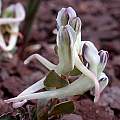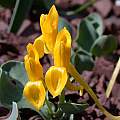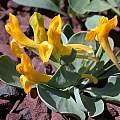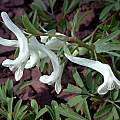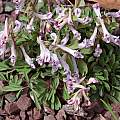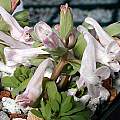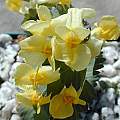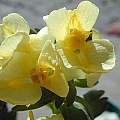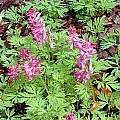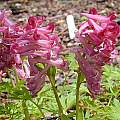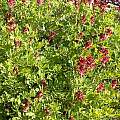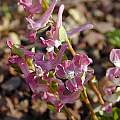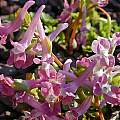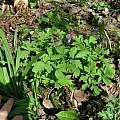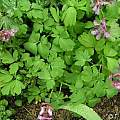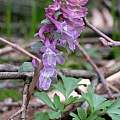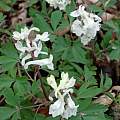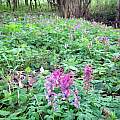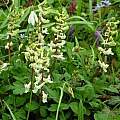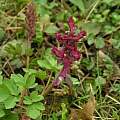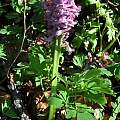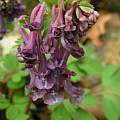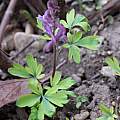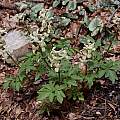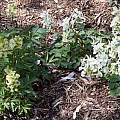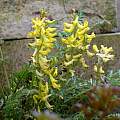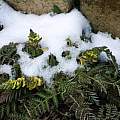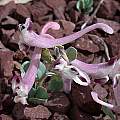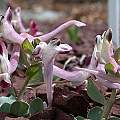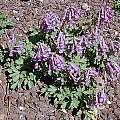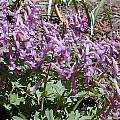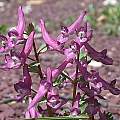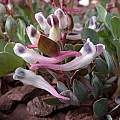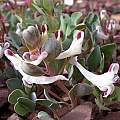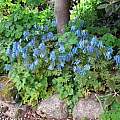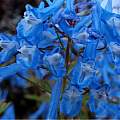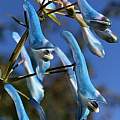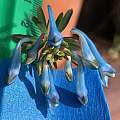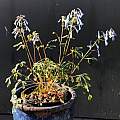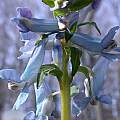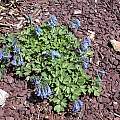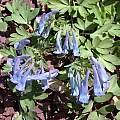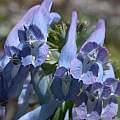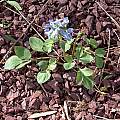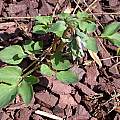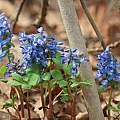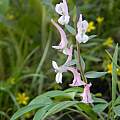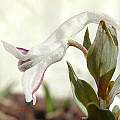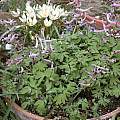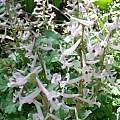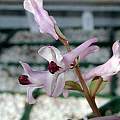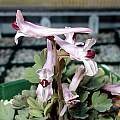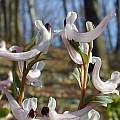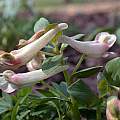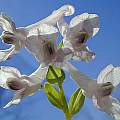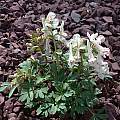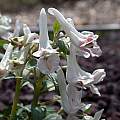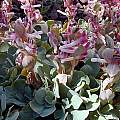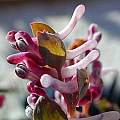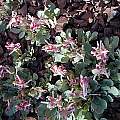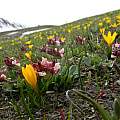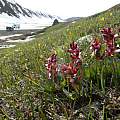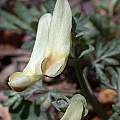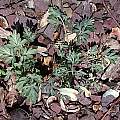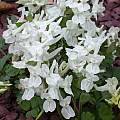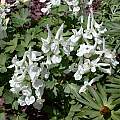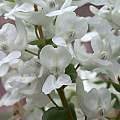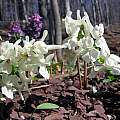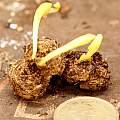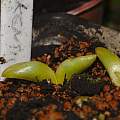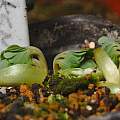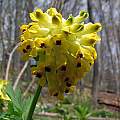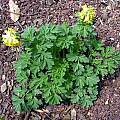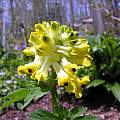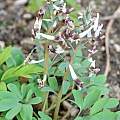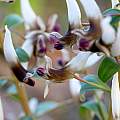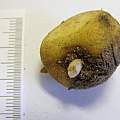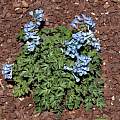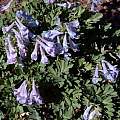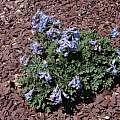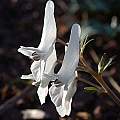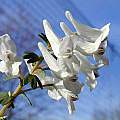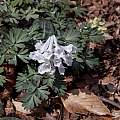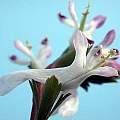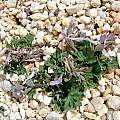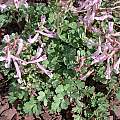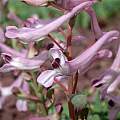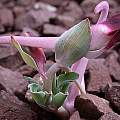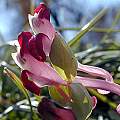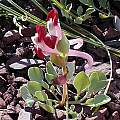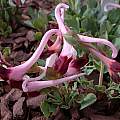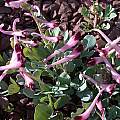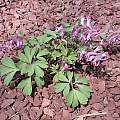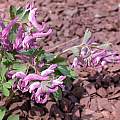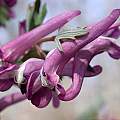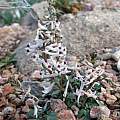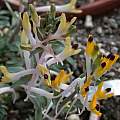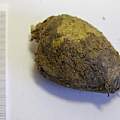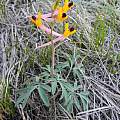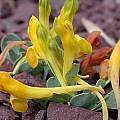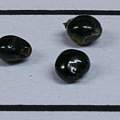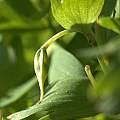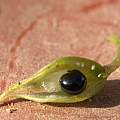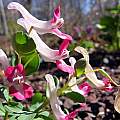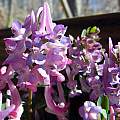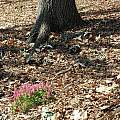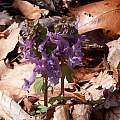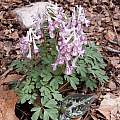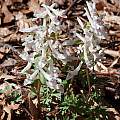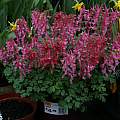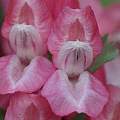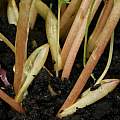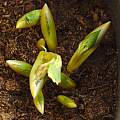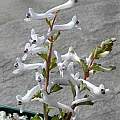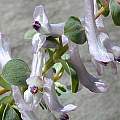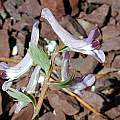This page shows an overview of all the species of Corydalis in the wiki. For information on the genus and links to the single species pages see Corydalis.
Corydalis afghanica Gilli is a species with grey green foliage and white or pale pink flowers native to North Afghanistan where it grows in rocky places. A dry summer or bulb frame protection is recommended. Height range: 20-30 cm. Photograph of Corydalis afghanica ssp. elegans by John Lonsdale.
Corydalis aitchinsonii Popov is native to Afghanistan and adjacent countries where it grows in rocky places. It has grey leaves and bright yellow flowers often changing to orange as they age and needs a dry dormant period. Height range: 30-45 cm. Photographs by John Lonsdale.
Corydalis angustifolia (M.Bieb.) DC. is native to the Caucasus, Turkey, and the Elburz Mountains of Iran where it is found in forest and scrub. It has a tuber that is almost corm like. It is very similar to Corydalis solida. It has white to creamy yellow flowers with inner petals with internal tips of purple and leaves with narrow deeply divided linear lanceolate leaflets. Bracts are divided into threes. This species is reported to grow well in woodland conditions or a pot kept just moist. Height range: 5-15 cm. Photographs by John Lonsdale.
Corydalis angustifolia 'Talish Dawn' is a selection made by Jānis Rukšāns with pink tinged flowers. Photographs by John Lonsdale.
Corydalis bracteata (Steph. ex Willd.) Pers. is from the foothills of the Sayan mountains in central Siberia and has been in cultivation since the early 19th. century. Every year in the late summer whilst the plant may appear to be dormant a new tuber grows from within the old one see here. Jack Elliott recommended growing it in a shady position in well drained but humus rich soil. The name bracteata derives from the plants bracts. Height range: 30-45 cm. Photographs by John Lonsdale.
Corydalis buschii Nakai is a woodland species from eastern Asia (Russia, China, North Korea) where it grows in moist meadows and glades. It has stolon-like tubers and divided stem leaves with pointed leaflets and dense racemes of pinkish purple flowers. Height range: 10-20 cm. Photographs by John Lonsdale.
Corydalis caucasica DC. is a woodland species from the Caucasus. Although it is very like Corydalis solida, it is distinguished by undissected bracts and an expanded lip to the lower petal. Photographs by John Lonsdale.
Corydalis cava (L.) Schweigg. & Körte (syn. Corydalis bulbosa Pers.) is a woodland plant native to Europe and western Asia. Its common name is 'hollow root' which agrees with the Latin meaning of 'cava', concave or hollow. Another common name, 'stagger weed' (referring to grazing animals), hints at its pharmacological uses; it contains a number of alkaloids: bulbocapnine, corydaline, corycavine and corydine. Other characteristics are: no prophyll, bracts untoothed, flowers scented. It has an unusually shaped perennial tuber which increases in size every year. Photographs 1+2 by Janos Agoston, pictures 3-5 by Martin Bohnet, showing the species in a deciduous forest habitat, where it often occurs in masses.
Photographs by Janos Agoston and Martin Bohnet of various forms.
Corydalis cava subsp. marschalliana (Willd.) Hayek (syn. C. marschalliana) is a form with cream or pale yellow flowers. It is native to the Balkans, Crimea, Caucasus and northwest Iran. Photographs by John Lonsdale, in the second C. solida appears on the right, note the difference in the leaves.
Corydalis cheilanthifolia Hemsl. is a robust, evergreen species from Chinese mountain regions. Besides being dependable and prolific bloomers, the plants provide all-year interest with their fine fern-like leaves which inspired the species name. Untypical for Corydalis, its seeds can be stored dry without harm. Photographs by Martin Bohnet.
Corydalis chionophila Czerniak. is a tuberous species growing in stony places in Iran. Its grey green leaves are not very divided. White flowers with purple tips are in a few flowered raceme. Height range: 30-45 cm. Photographs by John Lonsdale.
Corydalis decipiens Schott , Nyman & Kotschy is a name that was published in 1854 used to describe a form that grows to 25 cm in height that has grey-green, divided leaves and erect racemes of two-lipped purple flowers in spring. The Plant List has listed it as a synonym of Corydalis pumila but you can find other references on the web that describe it as related to or a synonym of Corydalis solida. Photographs by John Lonsdale.
Corydalis erdellii Zucc. is a montane plant found in Israel and Turkey. It blooms for a short time in nature after the snow melts. Height range: 30-50 cm. Photographs by John Lonsdale.
Corydalis flexuosa Franch. is a true-blue flowering species native to Sichuan province, China. Height range: to about 40 cm. The first photo below by Ian Young is from a June 2015 issue of Ian Young's Bulb Log which features this species and the second photo from the cover of a May 2010 issue.
'Porcelain Blue' is a cultivar offered by Annie's Annuals where in Richmond, California it bloomed spring thru fall. It is said to need mild summer temperatures and consistent moisture. Photos below by M. Gastil-Buhl are of a plant from that source: a close-up of the flower structure, a comparison of color to blue tape, and the shape of the plant. The leaf tips of this cultivar are more rounded and less dentate than the species.
Corydalis fumariifolia Maxim. has light blue or indigo flowers, rarely purple or white, with the inner petals nearly white. It is native to light woodland and open stony ground in China, Korea, and Russia. Height: to about 45 cm. Photographs by John Lonsdale.
The photo below is from Judy Glattstein who wondered about its identity. In her garden it is reliable, increasing slowly. It was identified as this species.
Corydalis glaucescens Regel is a dry land species native to the Tien Shan and the Pamir-Alai mountains in Central Asia. It has several ascending stem branches from the scale leaf, deeply divided leaflets and a few flowered raceme of pale pink to purple small nodding flowers. It needs a dry summer. Height range: to about 25 cm. The photo below is by Andrey Dedov taken in the Altai Mountains.
Corydalis glaucescens 'Medeo' is a selection in which the pink tinged petals have a rose-lilac central stripe. Jānis Rukšāns comments "Collected near the high mountain skating rink Medeo in Kazakhstan during my first mountain trip". Photograph by John Lonsdale.
Corydalis henrikii Lidén is native to Turkey. It has finely divided leaves and pale pink to white flowers, with dark or purple tips on the inner petals. Height range: 30-45 cm. First photo by Jane McGary, second by Janos Agoston, remainder by John Lonsdale.
Corydalis kusnetzovii Khokhr. is native to the Caucasus where it grows in woods at 1000 to 2000 m. It is variable in size with white, cream or pale yellow flowers and hybridizes with Corydalis vittae. Height range: 30-60 cm. Photos from John Lonsdale.
Corydalis ledebouriana Kar. & Kir. grows on rocky hillsides in Central Asia. It needs cool conditions and high light to keep it compact. The grey green leaves have elliptic to round leaflets. Height: 25 cm. Flowers are pale pink with pinkish-purple lips. The first three photographs were taken by John Lonsdale of garden plants.
Photographs by Andrey Dedov of plants in the Altai Mountains.
Corydalis magadanica A.P.Khokhr. is a rare plant from Siberia growing in spaghnum moorland in a cold and humid climate. It has divided leaves and white or greenish yellow flowers and needs to be grown in a cool spot and mulched to protect it from emerging too soon. It should be kept slightly moist during dormancy. Height range: 30-45 cm. Photos from John Lonsdale.
Corydalis malkensis Galushko comes from the Northern Caucasus, the valleys of the Kuban and the Malka rivers, taking its name from the latter. It is a spring time woodlander, only above ground for around 3 months of the year. Given the RHS Award of Garden Merit. Height: 15 cm. Photographs by John Lonsdale.
Photographs by David Pilling, the first shows tubers, the second and third the development of shoots between December and January.
Corydalis maracandica Michajlova is a central Asian species with blue-green leaves and white to pale primrose flowers with a darker yellow mouth. Height range: 30-45 cm. Photograph by John Lonsdale.
Corydalis nobilis (L.) Pers. is from Siberia and Kazakhstan. It was introduced to Europe by Linnaeus and is generally considered vigorous. Height: to about 2 ft. Photographs by John Lonsdale.
Corydalis nudicaulis Regel is from Tadjikistan and grows on moist, north-facing slopes near streams and among shrubs. While the plants show a typical growth pattern for section Corydalis, the flowers are highly unusual in their coloration, combining a white base color with deep coffee-brown shading and purple tips of the inner petals. Photos by Martin Bohnet except tuber photo by Peter Taggart.
Corydalis ornata Lidén & Zetterlund is found in the cold wastes of southeastern Russia. There are many forms in cultivation in shades of blue, purple and white. This species is reported to do well in cold temperatures, half shade, and a well drained peaty soil. Height range: 30-45 cm. Photos from John Lonsdale show different colored forms that he grows.
Corydalis paschei Lidén is only known from two small colonies in SW Anatolia, Turkey where it grows on moist rocky slopes. The pale pink to violet-pink flowers are large with broad outer petals and an ascending inflated spur and are held in a lax raceme on long pedicels. The foliage is divided and subdivided into three curled and twisting leaflets. Although very rare in the wild, it is considered easy to grow in leafy loam in light shade. Height range: 30-45 cm. Photos from John Lonsdale.
Corydalis popovii Nevski ex Popov grows in rocky places in the Pamir-Alai Mountains in Central Asia. This species has large flowers, usually deep purple on the upper and lower lips and paler lower with a pink to white spur and blue-green leaves. Height range: 5-10 cm. Photographs by John Lonsdale.
Corydalis pumila (Host) Rchb. is found in deciduous forests on slopes in low precipitation areas of Europe. It is related to Corydalis solida. It has 3 to 8 white to pale reddish purple flowers with darker lips. Height range: 15-30 cm. Photos from John Lonsdale.
Corydalis ruksansii Lidén is native to the steppe of Tajikistan and Uzbekistan at altitudes of 1500 to 2500 m (4920-8200 ft) where it grows in humus rich soils. Growing to 15 cm, it has divided leaves and narrow, small white flowers with purplish pink midveins in the outer petals. The inner petals are tinged with purple. This species is named after bulb expert Jānis Rukšāns. Height: 15 cm. Photographed by Bob Nold in his garden near Denver, Colorado.
Corydalis schanginii (Pall.) B.Fedtsch. is distributed from the western corner of Mongolia to the Black Sea where it is found in summer dry areas at an altitude of 500 to 2000 m (1640 to 6560 ft). Height range: 10-40 cm. There are two subspecies. Subsp. schanginii has rosy purple flowers with a narrow rim bordering the lower petal.
Subsp. ainae Rukšāns ex Lidén is from the Kara Tau Mountains of Kazakhstan. It lacks the rim and has a yellow front and is a slenderer plant with loose racemes. Liden and Zetterlund call it "a gem of the genus." The first photo by Jane McGary shows a selection made by the introducer, Jānis Rukšāns, under the name 'Berkara', here growing in a roofed raised bed of coarse sand over loam in Portland, Oregon. Given a free root run the plant becomes fairly large and robust, producing many racemes of large, showy flowers in late winter. The tubers divide slowly. It can tolerate summer rain out of doors but this may be risky. It enjoys a lot of water during its spring growing spurt, but can be kept very dry in summer and autumn. The second photo by Peter Taggart shows the tuber. The last photo is of a plant in habitat by Andrey Dedov.
Corydalis sewerzowii Regel is a species from northeast Iran, Afghanistan and adjacent countries. In has yellow flowers and biternate leaves (the three primary leaves were again divided into three.) Height range: 30-45 cm. IPNI and World Flora Online in 2025 have a different spelling, Corydalis sewerzowi Regel, but Plants of the World Online shows it as an accepted species and there are photos of it on iNaturalist. More confusing, **Corydalis sewerzowii var. simplicifolia** Fedde is considered by both Plants of the World Online and World Flora Online to be a synonym of Corydalis aitchisonii. But that name is not in IPNI. Photograph by John Lonsdale of a plant he grew under the name Corydalis sewerzowii.
Corydalis solida(L.) Clairv. is native to Europe and Asia and is found in meadows or woodlands. There is considerable variation in the leaves and the flower color, the latter varying from white to pink and purple with the most common color being dull purple. There is also a deep reddish-brick form and many attractive cultivars with interesting markings. Height range: 15-30 cm. Photographs of seeds on a 10 mm grid and bulbs by David Pilling. In the last one the clear to white elaiosome, an attachment to the seed which can be eaten by ants, is visible.
Photographs of various forms by John Lonsdale.
'Beth Evans' is one popular cultivar. In the garden it behaves like other Spring bulbs, starting to grow at the end of Winter, flowering and then dying back by the start of Summer. It has proved trouble free. Photos by David Pilling. The third one shows the prophyll or scale-leaf which is used to distinguish various species of Corydalis. Photo four shows shoots appearing.
Corydalis vittae Kolak. grows in subalpine limestone meadows in Georgia at the elevation of 2200 m (7200 ft). It has deeply divided leaves and 6 to 16 flowers, white tinged purple with the spur of the upper petal curving upward. Plants grown as this species are sometimes Corydalis kusnetzovii instead. That species is more robust with the upper petal less ascending and even down-curved. Height range: 15-30 cm. Photo from John Lonsdale.
Corydalis wendelboi Lidén grows on stony hillsides from 700 to 2000 m (2300 to 6560 ft) elevation in Western Anatolia, Turkey. It flowers in May and June. It has grey-green, deeply lobed leaves and pale purple flowers with the inner tepals tipped deep purple. Some advise growing it in a bulb frame or alpine house, but Tebbitt, et.al. write that it is suitable for the rock garden as well. Height range: to about 20 cm. Photos from John Lonsdale.
